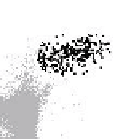Biology Reference
In-Depth Information
Figure 18.2. Comparison of CD8
T-cell IFN-g responses to 15-mer peptide mixes derived from
various HIV protein subunits. Represented in this analysis are gag, env, pol, nef, rev, vpr, and tat.
Mixes were generated as 15 amino acid sequences overlapping by 11 amino acids.
agents have signi®cant disadvantages. These include associated toxicities, the
development of drug resistance, and cost. The development of a successful im-
munotherapeutic vaccine would represent a signi®cant advance in treatment
modality to overcome these problems. In addition, there is a pressing need to
develop e¨ective prophylactic HIV vaccines to address the signi®cant HIV in-
fections that plague a number of nonindustrialized countries.
The speci®c immune mechanisms necessary to elicit HIV vaccine protection
remain unde®ned. Although combination antiviral drug therapy seems to par-
tially reconstitute immunity to microbial antigens, it has not yet demonstrated
an e¨ect on enhancing immune responses to HIV antigens in chronic HIV in-
fection (Angel et al., 1998; Autran et al., 1997; Kelleher et al., 1996; Lederman
et al., 1998; Rinaldo et al., 1999). In contrast, strong HIV-speci®c T-helper
immune responses to core proteins have been demonstrated in subjects with
nonprogressive disease and in patients with primary infection on antiviral drug
therapy ( Haas et al., 1997; Lisziewicz et al., 1999; Rosenberg et al., 1997;
Schwartz et al., 1994). In earlier studies, we examined the cellular cytokine re-
sponses to HIV antigens as a consequence of in vivo immunization with a
preparation of gp120-depleted whole-killed immunizing antigen ( HIV-1). This
study demonstrated increases in frequencies of memory CD4
T cells as a
consequence of in vivo immunization with HIV-1 antigen in HIV-1 seropositive
subjects placed on long-term HAART therapy (Maino et al., 2000). The ob-
served role of CTL in the containment of AIDS virus replication suggests that
























